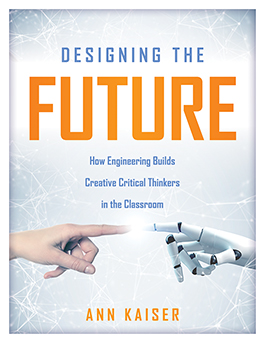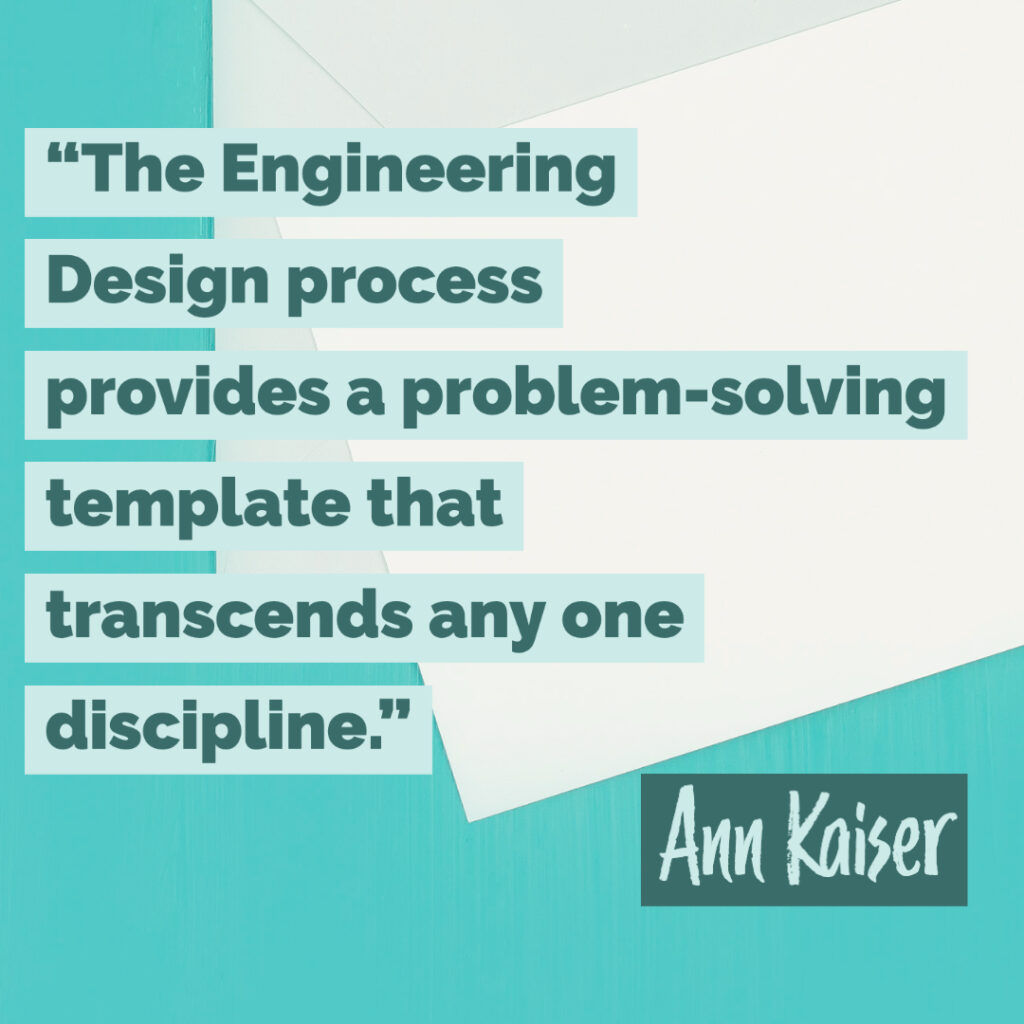What does it look like to design for the future? When we talk about the skills students need for success, engineering design might not be at the top of your list… yet. If you aren’t familiar with the term, this blog post has you covered.
Last year I connected with Ann Kaiser. She is the author of Designing the Future: How Engineering Builds Creative Critical Thinkers in the Classroom. Ann took the time to answer my questions about engineering design. And she shared some strategies you can put into practice right away, too. If you aren’t familiar with Ann’s work, she is the founder and chief executive officer of ProjectEngin. ProjectEngin a STEM education consulting firm focused on integrating engineering design in K-12 classrooms.
Engineering Design in K-12 Classrooms
Here’s my interview with Ann, all about engineering design and her new book Designing the Future!
What motivated you to write a book on this topic?
We live in a very complex, highly designed world. But very little of what we teach in our classrooms makes the connection between what students learn and how and why that designed world gets created and developed. The children in our classrooms are our future; expecting them to solve complex problems that have resulted from the technologies and solutions we have developed is unrealistic if we don’t provide some understanding of the design process. A large part of my motivation for writing this book is to bring that designed world into the curriculum.

In addition, the Engineering Design process provides a problem-solving template that transcends any one discipline. The engineering mindset embraces learning from failure, the consideration of multiple options, the idea that every choice has consequences, and a focus on the needs of the intended user. It provides a platform for the divergent thinking and collaborative work that is needed in many career paths but that is often absent from the convergent model of traditional education that focuses on one right answer and individual achievements.
Why is this topic important to you?
This topic is important to me because I have always realized that my training as an engineer allowed me to approach problems and challenges in a productive and reproducible way. Once I moved from engineering to education, I began to re-engineer how I taught by trying different approaches, new topics and challenges, and continuously reflecting on what worked and what didn’t. My goal was to always be able to answer the dreaded question – “When am I ever going to use this?” Now, more than ever, learning needs to be relevant to the students in every classroom. There is too much to learn and too many places to go for information. Providing a problem-solving approach that helps students to identify needed knowledge, key connections, and potential consequences should be one of our primary goals as educators.
But I am keenly aware that teachers have too much to teach already. In most areas, curriculum is far too broad. It is not fair to ask teachers to teach more. I think of what I do as helping them to enhance not increase what they teach. It is not about what they teach in terms of specific curriculum; it is about how those concepts get woven into a design challenge. No engineering design challenge “lives” in just one discipline and the engineering “habits of mind” center on the skills we are all encouraged to teach (creativity, critical thinking, communication, collaboration, empathy, and systems thinking). By incorporating the Engineering Design Process into projects and activities, teachers can connect to both the real world and to skills-based learning while teaching the core concepts that make up their curriculum.
For teachers who are new to using a design process with students, is there an activity that can help them get started?
At ProjectEngin, we always suggest that teachers start with activities that will support a classroom culture that sees value in failure, diverse ideas and talents, and empathy for the needs of others. Without that culture, more extensive and complex design challenges will be very difficult to implement. Chapters 1 and 2 of Designing the Future talk about that in detail. Chapter 4 has lots of suggested activities that can help teachers begin to develop that culture in their classrooms.
I would suggest that teachers focus on three main ideas as they work to develop this culture:
Good design starts with understanding the needs of others.
The “Name Your Pain” activity discussed on page 105 of the book is an excellent place to start. It gives students (or someone they know) a chance to “vent” about the one thing that really annoys them every day. They then get to feel special as a partner tries to engineer a solution that might address their pain point.
There are always multiple options for a solution.
Teachers tell me that this concept gets harder to convince students of as they get older; they have mastered the technique of finding that one right answer that gives them a good grade. Providing fun, low-risk opportunities for divergent thinking separate from any specific project is a good way to encourage creativity. Challenging students to redesign their classrooms or desks using creativity techniques such as SCAMPER (p. 116, Designing the Future) is certainly a great way to engage students plus it gives you some insight into how they view learning.
We can learn a lot from failure.
We often remember what doesn’t work better than what works. Engineers view failure as a way to continuously improve design. The Wright Brothers are a classic illustration of learning from previous failures. Many classrooms are “no-fail zones” with serious consequences for mistakes. We use short, low-risk activities called Quick Builds to introduce concepts in most of the projects we design. They are designed to fail most of the time and they are never used for assessment purposes.
Learning from failure is discussed on page 96 of the book and it is followed by some Quick Build activities that are easy to implement. The Tower of Power activity is probably the easiest to start with. Newspaper, tape, and a tennis ball can make for a fun challenge as student groups build paper towers to withstand a “wind storm” created by a fan or hair dryer. The most important part of a quick build is to have students observe how structures or objects feel and to give them time to reflect on possible improvements. I am always amazed at the number of “teachable moments” that can result from making things fall down!
On the blog, I discuss lots of ways to bring creativity into your classroom. Is there a particular EdTech tool that you’ve found support creativity in the classroom?

In a nutshell, Engineering Design, is about defining a problem, considering multiple options, and developing a solution. Creativity is really highlighted in that second phase – considering multiple options. And that is often the phase that gives teachers and students the most challenges. Divergent thinking is not really a part of the traditional approach to education. Younger students are better at it, but from grades 3-4 on it becomes more and more of a struggle.
We often suggest that teachers do some simple activities that ask students to combine disparate words or technologies. For instance, what can you create by combining the physical properties or attributes of an orange and a book. (Maybe a book with pages you peel rather than turn or chapters that are arranged as segments; or even a book with orange recipes) Random word generators can be useful for that and two of the sites that I like are Watch Out 4 Snakes and WordCounter.
The other thing I am a big fan of is the use of Post-Its or sticky notes for brainstorming. Using the PostIt app can help student groups organize ideas. They can take a picture of their physical notes or create notes directly in the app. The app can also cut down on the expense of buying PostIt or sticky notes if that is a concern. Plus group members can share it outside of the classroom. Any sticky note app can also be helpful.
The term “engineering” might seem intimidating to classroom teachers without much STEM experience. How do you frame this term when talking to teachers new to this concept?
We all engineer. Every time you have a problem, the process you follow is actually much closer to engineering design than it is to the process that is typically followed when you take a test in school. I always start workshops out by stressing that getting dressed to get there (or anywhere) is an engineering design challenge. You define the challenge – “getting dressed for a professional workshop”. You determine your constraints based on what is in your closet (and maybe what is clean). Then, you identify the criteria for an acceptable outfit.
Clearly, you would not dress for a workshop as if you were going to the beach or a formal gala. Or maybe, your own personal criteria dictate that this is not a day for a bright outfit or a very dark look. You consider multiple options and combinations. You develop a solution by putting on your outfit. Then, you might even make some modifications if something does not look quite right. And then, off you go to “communicate” your solution to the world. Most of the problems and challenges we face require us to engineer a solution. Engineering is often how we interact with our world.
I also stress to teachers that my approach is not about the highly technical aspects of engineering. It is about giving students a taste of what it means to design and about empowering them to identify solutions rather than focusing on problems.
In your book, you discuss how to adapt engineering design activities to different subject areas. Is there a particular story of a cross-curricular activity you’d like to share?
It is difficult to pull out one activity to share since they almost all become cross-curricular if they are developed and implemented well. One of the suggested project types that is guaranteed to incorporate concepts from many disciplines is to engineer a board game which is discussed in detail on starting on page 152 of Designing the Future.

Perhaps the most successful version of this project I have seen is in a 6th Grade Spanish language class. The students were given different groups of words and phrases (things like colors, health, food items, country flags and cultures, etc.) to help 3rd and 4th grade students learn Spanish. They learned how to interview people to find out what sorts of games were popular. They had to think through the mathematics of cost constraints and the challenges of meeting specified dimensions for both the game board and packaging (folding was needed). Then, they used Likert scales and statistics to identify needed improvements. They struggled with the technical writing skills needed to create playing instructions.
It was a multi-tasked project that put a high value on collaboration and synergy in order to meet deadlines. They needed to create a high level of visual appeal along with a logo and branding for their game. And they all ended up knowing Spanish much better, too.
Projects that involve disaster-resilient housing can connect to ELA in the lower grades (the 3 Little Pigs as civil engineers) and to climate change and the cultural meaning of home at the highschool level. In all grades, the basic physics of structures, materials, and stability can be included at an appropriate level.
What advice would you give a group of educators who want to hold a book club for your book?
The editorial team at Solution Tree Press has done a great job creating a Study Guide that can be found in the online resources for the book. Considering all or many of the questions it contains would provide a good framework for discussing the book.
I would also suggest that educators commit to implementing some of the ideas and activities to really develop an understanding of the message of the book. Chapter 4 has a number of short stand-alone activities that can help teachers change the culture in their classrooms. The Action Plan in Appendix A of the book can also provide a great roadmap for discussing and planning to use the book.
How can readers connect with you and learn more about your work?
I can always be reached by email at akaiser@projectengin.com or also through my LinkedIn page. In addition there are some helpful resources on my website, particularly in the Teachers Toolbox section. Teachers can also sign up for our newsletter which provides new tips and resources every month by filling in the Contact form on the website.
A ProjectEngin PLC will also debut online in the next few months. It will be hosted on the Participate.com website and it will feature resources and tips, along with the opportunity for support for teachers who are working to include Engineering Design in their classrooms. Our newsletter will contain updates about that initiative, too.
Getting Started with Engineering Design
If you’re ready to get started with engineering design this school year, Ann’s tips in this blog post are certainly a great place to start. I also encourage you to check out Ann’s website and follow along with her work on Twitter, too. Ann’s book is now available on Amazon, click here to grab your copy of Designing the Future: How Engineering Builds Creative Critical Thinkers in the Classroom.







